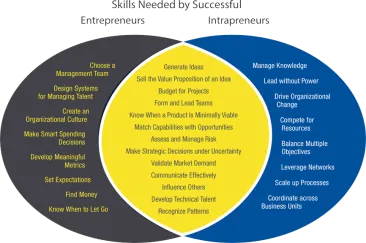The Best-Kept Tech Career Secret: Intrapreneurship

We have all heard about entrepreneurs who are changing or creating entire industries from the ground up, like Richard Branson (Virgin Airlines, Virgin Music and Virgin Galactic), Mark Zuckerberg (Facebook) and Elon Musk (Tesla). Entrepreneurship has led to many exciting innovations--but it comes with hefty risks and responsibilities.
If you’re not sure whether entrepreneurship is right for you, you may be interested to know about a related field. Intrapreneurship might get less press, but it leverages many of the same skills and can be every bit as challenging and rewarding while providing a more predictable and stable career path.
What characterizes these two types of innovation and how are they related? What are the risks and rewards of each? And what are the skills that today’s leaders need to succeed as both types of “preneurs”?

Entrepreneurship translated literally means to begin to take charge of an endeavor. The word Entrepreneur comes from the French verb entreprendre which means “to undertake”. Entrepreneurs organize and manage new businesses from the ground up--from the first seed of a great idea, to a fully realized product or service. They have the advantage of working outside an established system and get to make up the rules as they progress. Typically, they wear lot of hats -- from product development to marketing -- and often don’t have a stable paycheck. The financial rewards can eventually be huge and there’s no beating the adrenaline high.
The term entrepreneur has have been around for a long time -- since the mid-1800’s, according to the Google Books Ngram Viewer which displays word usage over time.

The word entrepreneur experienced its own lift-off somewhere around the late 1880’s, right around the time of the invention of the light bulb and phonograph by legendary inventor and entrepreneur Thomas Alva Edison. Entrepreneurs are responsible for many of the innovations that make modern life more efficient, social, healthy, and just plain fun. They thrive on the hair-raising roller coaster ride of their chosen career path and wouldn’t trade it for anything. Today, Thomas Edison would probably be drinking Red Bull and hustling for Series A funding.
Intrapreneurs, on the other hand, are innovators who start or manage new endeavors within established organizations--which comes with its own set of challenges and rewards. Unlike entrepreneurs, intrapreneurs usually have the advantage of being able to draw upon the support of well-developed infrastructure to aid in their efforts (hello, marketing department and human resources), not to mention a regular paycheck.

The concept of intrapreneurship as a discipline first appeared in the mid-1980’s, when it was championed by academic researcher Howard Edward Haller, management consultant Gifford Pinchot and Steve Jobs, who once described the Macintosh computer team as a "group of people going, in essence, back to the garage, but in a large company".
Because intrapreneurs are working within established entities, with an established culture, organization structure, and biases, intrapreneurs need to be adept at handling tricky situations like leading without power, building consensus, driving organizational change from within, and competing for scarce resources. Often they must add organizational challenges of an entrenched culture to the normal startup technical and marketing challenges in order to bring about innovation. This requires a great deal of skill and finesse and, when successful, intrapreneurs are rock stars within their companies.
Today, companies like Google, Intel and 3M have made intrapreneurship a key part of their business strategies and a not-so-secret weapon in their quest to continue innovating. Google’s famed “20 Percent Time” is an example of institutionalizing intrapreneurship across a large company, encouraging employees to take the time and space to pursue projects that are interesting to them, without regard to whether they fit their current job description. As these projects grow and demonstrate viability as new products, additional leaders are recruited to carry them to fruition.
Gmail, Adsense, Google Maps, and even the Google Ngram Viewer are all products that grew out of intrapreneurship through “20 Percent Time” projects. Intrapreneurship clearly is a great business strategy: today, Adsense revenue accounts for more than 25% of all Google’s revenue.

Successful leaders of entrepreneurial and intrapreneurial endeavors share some important qualities that help them succeed in their different environments. These include the abilities to sell the value propositions of new ideas, form and lead teams, assess and manage risk, and communicate effectively. Thus, both entrepreneurs who build new tech companies and intrapreneurs who create new ventures within established tech companies, need a lot of the same skills. They both also need some distinct techniques in their toolkits.
The body of knowledge about what makes successful entrepreneurs and successful intrapreneurs is growing rapidly. The faculty at the UCSB Master of Technology Management Program (MTM) conducts leading research on how teams work best, how information is shared within and between teams, and how leaders can create effective teams.
We also focused our curriculum on the important skills that entrepreneurs and intrapreneurs need to succeed. Beyond the latest research, our curriculum was shaped by in-depth discussions between our faculty and senior managers and recruiters within influential tech companies, founders of startups, and VCs. Our faculty learned what skills these leaders find most valuable, what these leaders look for among new hires to identify those with high leadership potential, and what skills and education they otherwise find lacking in their early-career engineers and scientists. MTM’s faculty then tailored the MTM curriculum to teach the proper framework and techniques and build the key skills through hands-on learning. We also learned that no other educational program has met with these companies to shape curriculum to meet the company needs.
--The Master of Technology Management (MTM) program at UC Santa Barbara is designed to catapult engineers and scientists into leadership positions — within both startups and established companies. This 9-month, intensive program is designed to teach the frameworks, skills, and techniques you need to be a successful technology manager. No fluff, no filler. The MTM degree will get you further, faster.

 Facebook
Facebook Instagram
Instagram LinkedIn
LinkedIn Twitter
Twitter